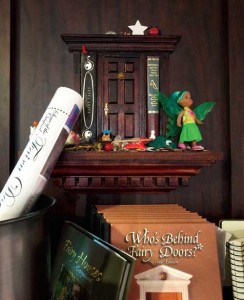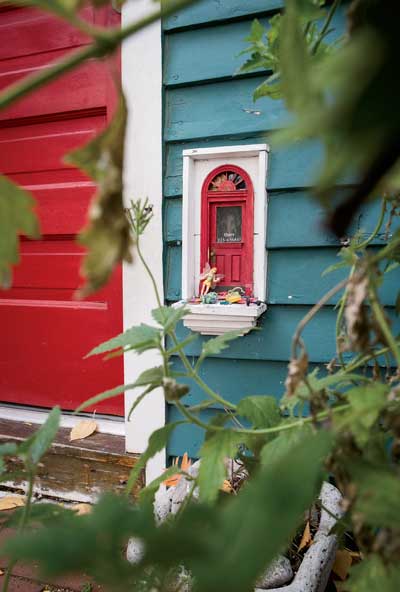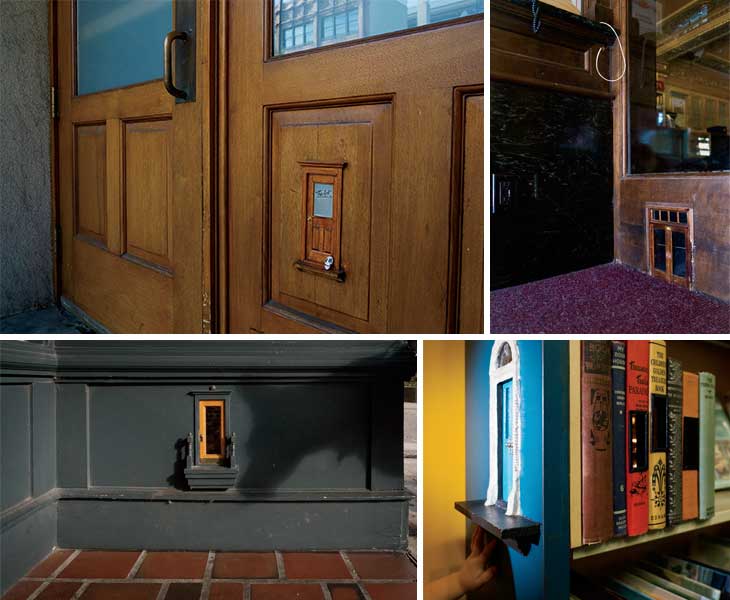Delaney Wright was 6 years old when she found a new fairy door in her Ann Arbor home.

The door was located on the surround of a huge wooden fireplace that her father, Jonathan Wright, ’83, had just built. It was only a few inches high and next to a little tile porch. On the porch was a tiny, tied plastic bag—apparently, it was garbage collection day for whoever lived there.
Now 21, Delaney remembers jumping down and staring at it, trying the small doorknob and actually opening the door. She peered inside to see a staircase spiraling up to a landing—and a second, locked door. This fairy door was the second in her home, the first having appeared before Delaney was born. And there would be more over the years as well, appearing as if by magic.
“I’ve spent countless hours on my hands and knees staring at all of the fairy doors,” says her older sister, Samuelina, 23. “Friends were usually amazed by it. They’d all end up opening the doors and trying to see what’s in every corner.”
Adds Delaney: “I’m not sure when my sister and I figured out it was my dad.”
Officially, Jonathan Wright is not a builder of fairy doors. He’s a “fairyologist” who “discovers” the doors. The first appeared in the Wright home in 1993, and more followed both inside and out. Then, in 2005, he started “discovering” (wink, wink) fairy doors downtown—at the Peaceable Kingdom gift shop, at The Ark concert hall, next to some tables at Sweetwaters Coffee & Tea, on a bookshelf at the Ann Arbor District Library.

Today, the fairy doors of Ann Arbor are world-famous. The Washington Post, the Associated Press, and National Public Radio have all run stories about them. A few years ago, the BBC sent over a film crew, complete with actors in fairy and elf costumes. The Ann Arbor Area Convention & Visitors Bureau even offers a map so visitors can take a fairy door tour. They’re also documented on Wright’s website, urban-fairies.com.
Fairy doors have become a worldwide business. The Irish Fairy Door Co., located near Dublin, began in August 2013 and since has sold 400,000 fairy doors to customers in 80 countries, including the United States, according to the firm. There’s also at least three mail-order fairy door firms located in Australia.

It remains a mystery whether today’s fairy door trend dates back to Wright. For instance, the Irish Fairy Door Co. says the company was inspired after seeing fairy doors for sale at a shop in upstate New York, according to co-owner Niamh Barry. The shop in question was called the Thruway Market, a unique emporium in Walden that sold everything from guns to groceries. Was that line of doors from an artist who saw Wright’s work? The woman who ran Thruway at the time did not return a call asking for comment.
Regardless, many—including Wright—think it all started with his first fairy door back in 1993.
“He’s the mastermind,” says Catherine Thursby, owner of the Ann Arbor store Red Shoes. With Wright’s blessing, she makes her own fairy doors for sale. “He could have done really well with it and made quite a bit of money. But he was approaching it from a more artistic, not commercial standpoint.”
While Wright never set out to make money from fairy doors, he sometimes has regrets. Artistic integrity, after all, is not often profitable.
“It’s my own damn fault,” Wright says. “I know it could have been me (making money), but it was a path I chose not to take, exploiting the phenomenon in that manner.
“I can’t blame them,” he adds. “The concept is great. Other people wouldn’t have jumped on it if it wasn’t a great concept. That’s capitalism.”

Sitting at the aforementioned Sweetwaters, across from one of his fairy doors, Wright looks much younger than his 56 years—perhaps due to prolonged exposure to fairy dust? He’s cheerful company, quick to interrupt his own comments with laughter. A lifelong Ann Arbor resident, Wright graduated from U-M with a degree in graphic design and now makes his living as a graphic designer and illustrator.
His interest in building extends back to studying architectural drafting in grade school. He intended to major in that subject before taking a more artistic turn during his college years. It probably didn’t hurt that Wright’s father, a salesman, was a “frustrated artist,” he says.
How did he dream up the fairy door concept? Wright has always been a fan of books such as “The Littles” and “Stuart Little,” children’s stories about tiny people. His wife, Kathleen, ’82, is closely tied to her Irish heritage and the mystical stories therein.
“I have looked for fairies, fairy doors, leprechauns under shamrocks, and unicorns in the mist, all my life,” says Kathleen, a teacher who ties the legends of fairies into her classroom work.

Anyone who sees Wright’s doors is astonished by the level of intricacy. The Peaceable Kingdom fairy door has a “Sorry, We’re Closed” shade that exactly matches the store’s front door. A hidden string allows the manager to pull it down when the store closes. The Ark door is a tiny fairy ticket window, which spits out actual tickets. The library’s door is located on a shelf in the children’s area, next to real books, hollowed out and fixed in place. Windows in the book spines allow visitors to peer inside.
When Wright takes people on a tour of the doors, he carries with him a pocket toolkit that includes a Swiss Army knife, a Leatherman- style multitool, dental picks, tweezers, and a flashlight for making tiny adjustments and repairs. Occasionally, overly enthusiastic passers- by break off pieces.
Today, it’s hard to say how many doors are located around Ann Arbor. Besides those in his house, Wright has “discovered” eight more downtown, although some no longer exist due to business closings. In addition, others have created some “unaffiliated” doors.

Wright has also discovered a “goblin door,” a narrow and elongated door located in a strip of concrete between two connected storefronts. It’s an odious-looking spot and meant to represent the more unpleasant aspects of imaginary beings. Wright doesn’t like to reveal the address: “It does not seem wise to encourage people to be monkeying around a goblin door,” he says.
Recently, Wright has dipped at least a toe into fairy door entrepreneurship. Through his company, Urban Fairy Operations (UFO), he’s produced a poster, Fairy Doors of Ann Arbor, which depicts all the doors that have been discovered over the years. He’s also crafted a book, “Who’s Behind the Fairy Doors,” in which he created detailed illustrations of what the fairies might look like based on children’s drawings.
Meanwhile, his wife is seeking to publish a children’s book that introduces fairy characters with names like Bean, Boggin, and Fairlight, who were inspired by the doors. The Wrights see potential for producing products inspired by these characters or for licensing the concept for anything from movies and action figures to clothes, toys, and games.
“Maybe I’ll sell out,” Wright says, laughing. He calls it his “get-rich-slow” scheme. “We’ve built enough of a framework and ground work for this that it’s got legs. Or wings.”

Fairy Door Finder
- C.S. Mott Children’s Hospital lobby, 1540 E. Hospital Drive
- Michigan Theater, 603 E. Liberty St.
- Ann Arbor District Library, 343 S. Fifth Ave.
- Sweetwaters Coffee & Tea, 123 W. Washington St.
- The Peaceable Kingdom, 210 S. Main St.
- Red Shoes, 332 S. Ashley St.
- The Ark, 316 S. Main St.
- Nicola’s Books (not shown on map), 2513 Jackson Road
Alan Wechsler, a freelance writer based in Albany, N.Y., recently spent a day touring the fairy doors of Ann Arbor. He has been published in The New York Times, The Wall Street Journal, and a variety of magazines and alumni publications.





